

A Brief Aboriginal History. “The very ink with which all history is written is merely fluid prejudice.”

Mark Twain. Government policy in relation to Aboriginal people - Barani. Colonial Secretary’s Building on the corner of Macquarie and Bridge streets, headquarters of the Aborigines Welfare Board (Mitchell Library, State Library of NSW - SPF / 248) Since the European invasion until very recently, government policy relating to Aboriginal people has been designed and implemented by non-Aboriginal people.
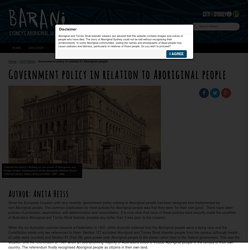
The common justification for most policies for Aboriginal people was that they were ‘for their own good’. There have been policies of protection, assimilation, self-determination and reconciliation. Indigenous Australia Timeline - 1901 to 1969 - Australian Museum. A timeline of events relating to Indigenous Australians from the time of Federation in 1901 until 1969.
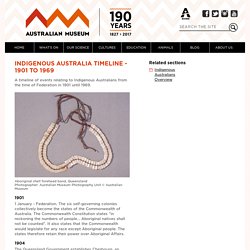
Aboriginal shell forehead band, Queensland Photographer: Australian Museum Photography Unit © Australian Museum 1 January - Federation. The six self-governing colonies collectively become the states of the Commonwealth of Australia. The Commonwealth Constitution states "in reckoning the numbers of people... Aboriginal natives shall not be counted". The Queensland Government establishes Cherbourg, an Aboriginal community, about 30 km from Gympie. The Western Australia Aborigines Act is passed. Australia's first Aboriginal member of parliament - ABC online education. Viewer advice - Aboriginal and Torres Strait Islander viewers are advised that the following media resource may contain images and voices of people who have diedOutside an official building, a reporter interviews Neville BonnerNEVILLE BONNEROh, I couldn't...MAN, REPORTERHow does it feel now that you're finally elected?

NEVILLE BONNERIt feels wonderful, I can assure you. The anxiety and everything is over, I know now that I am Senator Bonner, as it were. It's quite a wonderful feeling.MAN, REPORTERWhat does Senator Bonner intend to do before he goes to Canberra? NEVILLE BONNERWell, the first... The history of the Aboriginal Tent Embassy - History (6,10) Charles Perkins - Charles Perkins and the Freedom Rides. Where & When he was born Charles Perkins was born on the 16th of June, 1936 behind the old telegraph station (previosuly known as 'The Bugalow') in Alice Springs (Northern Territory) Australia.
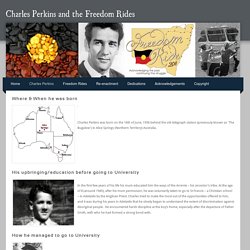
His upbringing/education before going to University. Australians Together. Why should I learn about the area where I live?
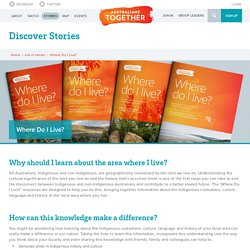
All Australians, Indigenous and non-Indigenous, are geographically connected by the land we live on. Passports please!: Immigration Museum. Citizenship isn't something I have consciously thought about until more recently.

My citizenship was gained through the efforts of my parents and their unexpected journey and sacrifices. As an adult, citizenship means I play a culpable part in my country's democracy and wellbeing, and realising my parents' hopes. Mick Dodson’s 2009 Australian of the Year speech: Immigration Museum. Mick Dodson, a Yawuru man from the Broome region in WA and Co-Chair of Reconciliation Australia, delivered his speech to the National Press Club on 17 February 2009.
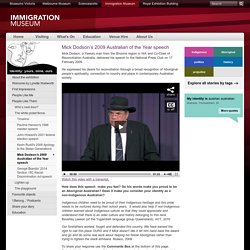
He expressed his desire for reconciliation through a broad recognition of Aboriginal people’s spirituality, connection to country and place in contemporary Australian society. Watch this video with a transcript. How does this speech make you feel? Do his words make you proud to be an Aboriginal Australian? Timeline - Refugee Council of Australia. Timeline: Immigration Museum. Scientists continue to debate racial hierarchies, always with white men at the top.
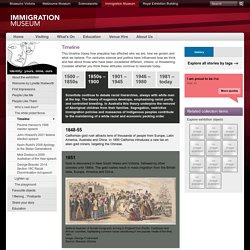
The theory of eugenics develops, emphasising racial purity and controlled breeding. In Australia this theory underpins the removal of Aboriginal children from their families. Segregation, restrictive immigration policies and massacres of Indigenous peoples contribute to the maintaining of a white racial and economic pecking order. 1848-55Californian gold rush attracts tens of thousands of people from Europe, Latin America, Australia and China. In 1850 California introduces a new tax on alien gold miners, targeting the Chinese.1851Gold is discovered in New South Wales and Victoria, followed by other colonies until 1890s.
Immigration Australia Timeline. Since the arrival of the First Fleet on the shores of Botany Bay in 1788, close to 10 million settlers have come from all corners of the globe to call Australia home.

Driven by the promise of a new life the Great Southern Land, waves of immigrants came to find fortune in the gold rush, to escape the social upheaval of the Industrial Revolution, two world wars and the aftermath of the Vietnam War. These migrants have played a vital role in shaping Australia’s history, forming the multicultural identity we pride ourselves on today.
Aboriginals When these first Europeans arrived they did not find an empty land as expected. Instead, they found themselves outnumbered by more than 500,000 indigenous Aboriginal people whose ancestors had lived in Australia for at least 50,000 years. Convict Transportation From 1788 to 1868 Britain transported more than 160,000 convicts from its overcrowded prisons to the Australian colonies, an arduous journey that took roughly 8 months by sea. Citizenship in Australia - Fact sheet 187 – National Archives of Australia, Australian Government. History of Australian citizenship At Federation in 1901, ‘British subject’ was the sole civic status noted in the Australian Constitution. The Australasian Federal Convention of 1897–98 was unable to agree on a definition of the term ‘citizen’ and wanted to preserve British nationality in Australia. An administrative concept of citizenship arose from the need to distinguish between British subjects who were permanent residents and those who were merely visitors.
This was necessary for the Commonwealth to exercise its powers over immigration and deportation. Australia's development as a culturally diverse nation - 1900s timeline. Commonwealth Racial Discrimination Act is passed, prohibiting discrimination on the grounds of race, colour, descent or ethnic origin. A mass anti-Chinese meeting is held in Hyde Park, Sydney. Coalition Government is elected - retains non-discriminatory immigration policy and begins to raise immigration targets.
Department of Immigration and Ethnic Affairs (DIEA) is established. Timeline: Indigenous rights movement. Here is an overview of the Indigenous rights movement from the beginning of the century. 1901: Commonwealth of Australia formed. Indigenous Australians are excluded from the census and the lawmaking powers of the Commonwealth Parliament. White Australia Policy.
Aboriginal history timeline (1900 - 1969) - Creative Spirits. <img src="/images/uploads/aboriginalculture/history/len-waters-street-ACT.jpg" width="400" height="267" alt="Photo of a street sign"/>Len Waters Street in Ngunnawal, Australia Capital Territory.The Methodist Church in North Australia sets up an Aboriginal mission on Elcho Island, Northern Territory.1943 A further amendment to the Aboriginal protection legislation in NSW gives two Aboriginal people - one ‘full-blood’ and one ‘half-caste’ - representation on the Aboriginal Welfare Board. Walter Page and William Ferguson, both Aboriginal Progressive Association members, take up the positions.An Exemption Certificate is introduced, exempting certain Aboriginal people from restrictive legislation and entitling them to vote, drink alcohol and move freely but prohibiting them from consorting with others who are not exempt.
Their children are allowed to be admitted to ordinary public schools.Aboriginal people use the derogatory terms ‘dog tags’ or ‘dog licences’ to refer to the certificates. History of the Indigenous vote. Updated: 14 April 2015 This publication is under review. Introduction. Events in Australian electoral history. Prior to European settlement Australia was occupied by groups of Aboriginal and Torres Strait Islander peoples led by elders and subject to traditional laws. European settlement occurred and Australia became a penal colony run by a governor (autocratic government).
Timeline: Recognition of Australia's Indigenous people. RightsEd: Australia as a nation – race, rights and immigration. Actions for Aboriginal Rights. Most social change is made up of small reforms that might seem insignificant at the time, but taken as a whole, can result in significant changes in society. If we look at the status of Indigenous rights since the 1930s we can note certain moments that altered perceptions and pushed particular boundaries.
Individually these moments were hard fought and involved sacrifices by the people involved that may appear out of proportion to the gain. However each step allowed the next to be taken, each achievement was a platform for the next to be built on. Here we have four sources that stretch across eighty years: 1938, 1967, 1972 and 2008. How did Australian society change throughout the twentieth century to become more equal? Case Study. Case Study Overview Today we expect all Australians to have equal citizenship rights and responsibilities. This involves such things as voting at elections, being free from discrimination or prejudice, getting equal pay for equal work, and being treated with dignity and respect. This has not always been the situation. It took a long time for some Australians, including women, Indigenous Australians, Indigenous children, orphans and migrants to win equal rights.